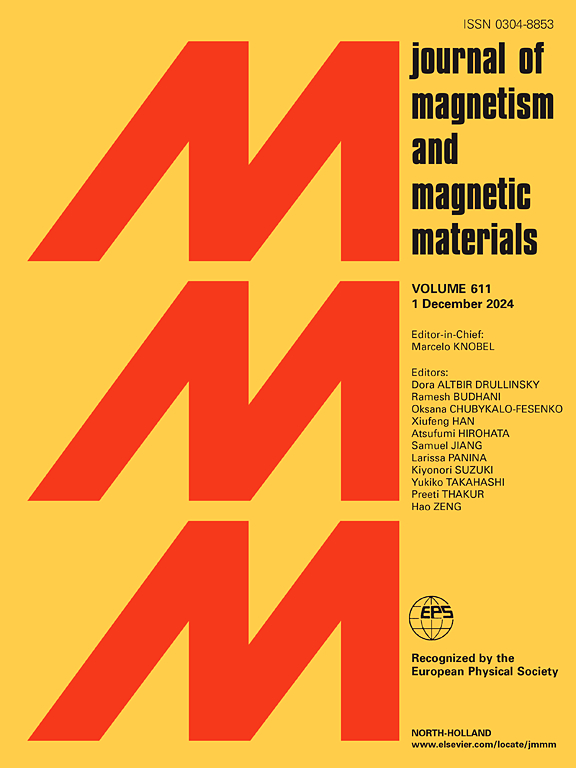Origin of weak ferromagnetism in Ti doped Bi0.9Nd0.1FeO3 ceramics
IF 2.5
3区 材料科学
Q3 MATERIALS SCIENCE, MULTIDISCIPLINARY
引用次数: 0
Abstract
The crystal structure, structural phase formation, ionic oxidation state and magnetic properties were studied for understanding the weak ferromagnetism of Ti doped Bi0.9Nd0.1FeO3 compounds in the 10–400 K temperature range. The crystal structure analysis performed by X-ray diffraction and Raman scattering revealed a distorted rhombohedral structure in Ti-doped samples. X-ray photoelectron spectroscopy identified a significant fraction of oxygen vacancies (∼5 %) and about 38 % of Fe2+ ions content which are the primary factors leading to a notable structural distortion. Magnetic measurements revealed the weak magnetic behavior in a wide temperature range. These observations have approved that titanium substitution is very effective tool to unlock the weak ferromagnetism; a mechanism responsible for the observed results is discussed in the context of lattice distortion, oxygen deficiency, and complex oxidation state of Fe ions. The release of a weak net magnetization in Ti-doped compounds is mainly caused by a disturbance of long-range incommensurate spin-cycloidal structure.
Ti掺杂Bi0.9Nd0.1FeO3陶瓷弱铁磁性的来源
为了了解Ti掺杂Bi0.9Nd0.1FeO3化合物在10 ~ 400 K温度范围内的弱铁磁性,研究了其晶体结构、结构相形成、离子氧化态和磁性。通过x射线衍射和拉曼散射分析,发现ti掺杂样品具有扭曲的菱形结构。x射线光电子能谱鉴定出大量的氧空位(~ 5%)和约38%的Fe2+离子含量,这是导致显着结构畸变的主要因素。磁性测量表明,该材料在较宽的温度范围内具有弱磁性。这些结果表明,钛取代是解除弱铁磁性的有效工具;在晶格畸变、缺氧和铁离子的复杂氧化态的背景下,讨论了导致观察结果的机制。掺钛化合物中弱净磁化的释放主要是由于远程不相称自旋摆线结构的扰动引起的。
本文章由计算机程序翻译,如有差异,请以英文原文为准。
求助全文
约1分钟内获得全文
求助全文
来源期刊

Journal of Magnetism and Magnetic Materials
物理-材料科学:综合
CiteScore
5.30
自引率
11.10%
发文量
1149
审稿时长
59 days
期刊介绍:
The Journal of Magnetism and Magnetic Materials provides an important forum for the disclosure and discussion of original contributions covering the whole spectrum of topics, from basic magnetism to the technology and applications of magnetic materials. The journal encourages greater interaction between the basic and applied sub-disciplines of magnetism with comprehensive review articles, in addition to full-length contributions. In addition, other categories of contributions are welcome, including Critical Focused issues, Current Perspectives and Outreach to the General Public.
Main Categories:
Full-length articles:
Technically original research documents that report results of value to the communities that comprise the journal audience. The link between chemical, structural and microstructural properties on the one hand and magnetic properties on the other hand are encouraged.
In addition to general topics covering all areas of magnetism and magnetic materials, the full-length articles also include three sub-sections, focusing on Nanomagnetism, Spintronics and Applications.
The sub-section on Nanomagnetism contains articles on magnetic nanoparticles, nanowires, thin films, 2D materials and other nanoscale magnetic materials and their applications.
The sub-section on Spintronics contains articles on magnetoresistance, magnetoimpedance, magneto-optical phenomena, Micro-Electro-Mechanical Systems (MEMS), and other topics related to spin current control and magneto-transport phenomena. The sub-section on Applications display papers that focus on applications of magnetic materials. The applications need to show a connection to magnetism.
Review articles:
Review articles organize, clarify, and summarize existing major works in the areas covered by the Journal and provide comprehensive citations to the full spectrum of relevant literature.
 求助内容:
求助内容: 应助结果提醒方式:
应助结果提醒方式:


